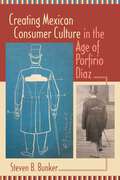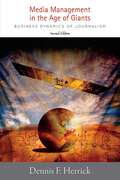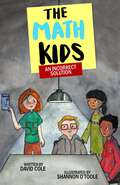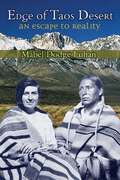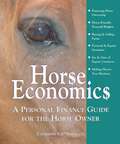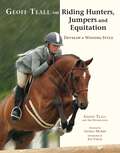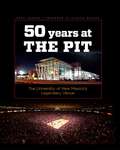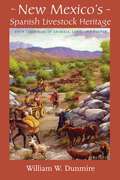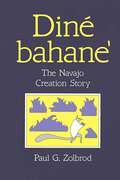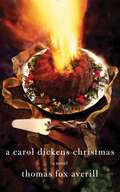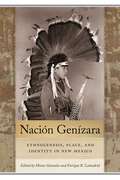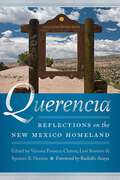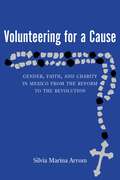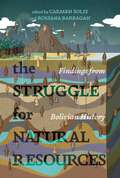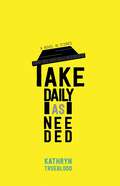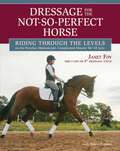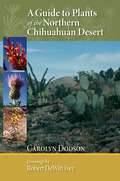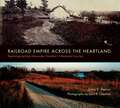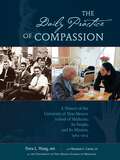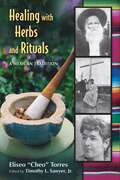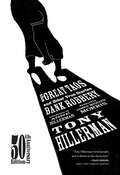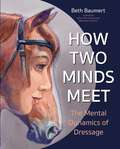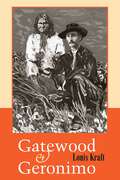- Table View
- List View
No More Bingo, Comadre!: Stories
by Nasario GarcíaIt takes all kinds to populate Northern New Mexico, and this book has every one: from gypsies and gamblers to ranchers and criminals. Noted author Nasario García introduces us to some of these people and the challenges they face. The title character, Adelfa, flirts with the glamour of casinos and finds herself addicted to gambling. Sam &“Spam&” Austin, an inmate serving a long sentence for murder, is paroled, attends medical school, and becomes a doctor. The affable grandfather in &“Yo Quiero Hacer un Lie &’Way,&” a hard-working and honorable rancher, stuns the proprietor of a mortuary with his request to put a coffin on layaway.
Creating Mexican Consumer Culture in the Age of Porfirio Díaz
by Steven B. BunkerIn Gabriel García Márquez&’s novel One Hundred Years of Solitude, a character articulates the fascination goods, technology, and modernity held for many Latin Americans in the early twentieth century when he declares that &“incredible things are happening in this world.&” The modernity he marvels over is the new availability of cheap and useful goods. Steven Bunker&’s study shows how goods and consumption embodied modernity in the time of Porfirio Díaz, how they provided proof to Mexicans that &“incredible things are happening in this world.&”In urban areas, and especially Mexico City, being a consumer increasingly defined what it meant to be Mexican. In an effort to reconstruct everyday life in Porfirian Mexico, Bunker surveys the institutions and discourses of consumption and explores how individuals and groups used the goods, practices, and spaces of urban consumer culture to construct meaning and identities in the rapidly evolving social and physical landscape of the capital city and beyond. Through case studies of tobacco marketing, department stores, advertising, shoplifting, and a famous jewelry robbery and homicide, he provides a colorful walking tour of daily life in Porfirian Mexico City. Emphasizing the widespread participation in this consumer culture, Bunker&’s work overturns conventional wisdom that only the middle and upper classes participated in this culture.
Media Management in the Age of Giants: Business Dynamics of Journalism, Second Edition.
by Dennis F. HerrickThe emergence of giant media corporations has created a new era in mass communications. The world of media giants—with a focus on the bottom line—makes awareness of business and financial issues critical for everyone in the industry. This timely new edition of a popular and successful textbook introduces basic business concepts, terminology, history, and management theories in the context of contemporary events. It includes up-to-date information on technology and addresses the major problem facing media companies today: How can the news regain profitability in the digital age?Focusing on newspaper, television, and radio companies, Herrick fills his book with real-life examples, interviews with media managers, and case studies. In a time when all the rules are changing because of digital technology, conglomeration, and shifting consumer habits, this text is a vital tool for students and working journalists.
An Incorrect Solution: The Math Kids (Book 5) (The Math Kids)
by David ColeFifth grade is off to a terrible start for the Math Kids. Jordan and Justin are in a different class from Stephanie and Catherine. Worse, they have Miller the Killer for math, and he hates math! Even more troubling, Jordan witnesses Robbie, the class bully, in an angry confrontation with his father and wonders if Constable Colson might be doing more than yelling. People problems suddenly seem a lot more challenging than homework, but maybe with the right plan—and some math—the four Math Kids can find a way to deal with their classroom woes and make sure Robbie stays safe. The Math Kids: An Incorrect Solution is the fifth book in the Math Kids series.
Edge of Taos Desert: An Escape to Reality
by Mabel Dodge LuhanIn 1917 Mabel Sterne, patron of the arts and spokeswoman for the New York avant-garde, came to the Southwest seeking a new life. This autobiographical account, long out-of-print, of her first few months in New Mexico is a remarkable description of an Easterner's journey to the American West. It is also a great story of personal and philosophical transformation. The geography of New Mexico and the culture of the Pueblo Indians opened a new world for Mabel. She settled in Taos immediately and lived there the rest of her life. Much of this book describes her growing fascination with Antonio Luhan of Taos Pueblo, whom she subsequently married. Her descriptions of the appeal of primitive New Mexico to a world-weary New Yorker are still fresh and moving. "I finished it in a state of amazed revelation . . . it is so beautifully compact and consistent. . . . It is going to help many another woman and man to 'take life with the talons' and carry it high."--Ansel Adams
Horse Economics
by Catherine E O'BrienMost horse owners don't have unlimited disposable income, and, unfortunately, equine-related financial decisions are often driven by their passion rather than sound, long-range planning. Here, the author explains how this potentially disastrous scenario can be avoided with the appropriate preparation. Horse Economics helps illustrate a complete financial picture for the horse owner, first by determining the true costs of horse ownership, and then incorporating these added expenses into a household budget. Chapters include information on managing credit, debt, retirement, and investment, as well as an extensive examination of purchasing, owning, maintaining, and selling horse property. The book also includes helpful worksheets for calculating net worth, cash flow, and more.
Geoff Teall on Riding Hunters, Jumpers and Equitation
by Geoff TeallA top trainer teaches you how to perfect a winning position, both on the flat and over fences.Discover how to increase the effectiveness of the time you spend in the saddle, whether you are a beginning hunt seat rider or a seasoned competitor. Geoff? Teall—noted judge, trainer, and clinician—helps you put together an unbeatable package, including:Setting riding goals.Finding the right horse and instructor.Developing confidence and facing your fears.Dressing for success in and out of the show ring.Geoff then demystifies the jumping course, showing you how even the most challenging, demanding patterns can be simplified and easily practiced at home. You&’ll discover the secrets of:Walking any course.Seeing distances.Single jumps and straight lines.Jumping from a turn.Angled jumps and end jumps.Combinations, in-and-outs, and more!Whether the first step on the road to a medal, or a tool to revitalize an experienced rider&’s passion for the sport,Geoff Teall on Riding Hunters, Jumpers and Equitationwill help put the pieces together for that perfect, polished round.
Fifty Years at the Pit: The University of New Mexico's Legendary Venue
by Gary HerronBasketball fans at the University of New Mexico have always been loyal, loud, and numerous, and the devotees have grown in number over the fifty years since the opening of the University Arena, a.k.a. the Pit, in 1966. Herron recounts many of the best players and games in this celebration of one of the best-known facilities in the United States.With almost two hundred color photographs, this illustrative explosion shows you the players, the plays, the coaches, and the sold-out crowds dressed in red. You can recall the colorful nicknames: Petie Gibson, Marvin &“Automatic&” Johnson, and, of course, &“Stormin&’ Norman&” Ellenberger. This stunning work also contains extensive statistics that will not disappoint—like who took the Lobos to the most postseason contests.Herron does not overlook women&’s basketball, a standout sport at UNM, nor does he omit the great non-UNM entertainment that has happened at the Pit: the NMAA state high school basketball tournament, the Gathering of Nations, boxing matches, bull riding, concerts, and more.
New Mexico's Spanish Livestock Heritage: Four Centuries of Animals, Land, and People
by William W. DunmireThe Spanish introduced European livestock to the New World—not only cattle and horses but also mules, donkeys, sheep, goats, pigs, and poultry. This survey of the history of domestic livestock in New Mexico is the first of its kind, going beyond cowboy culture to examine the ways Spaniards, Indians, and Anglos used animals and how those uses affected the region&’s landscapes and cultures.The author has mined the observations of travelers and the work of earlier historians and other scholars to provide a history of livestock in New Mexico from 1540 to the present. He includes general background on animal domestication in the Old World and the New during pre-Columbian times, along with specific information on each of the six livestock species brought to New Mexico by the early Spanish colonists. Separate chapters deal with the impacts of Spanish livestock on the state&’s native population and upon the land itself, and a final chapter explains New Mexico&’s place in the larger American livestock scene.
Diné Bahane': The Navajo Creation Story
by Paul G. ZolbrodThis is the most complete version of the Navajo creation story to appear in English since Washington Matthews' Navajo Legends of 1847. Zolbrod's new translation renders the power and delicacy of the oral storytelling performance on the page through a poetic idiom appropriate to the Navajo oral tradition.Zolbrod's book offers the general reader a vivid introduction to Navajo culture. For students of literature this book proposes a new way of looking at our literary heritage.
A Carol Dickens Christmas: A Novel
by Thomas Fox AverillIt&’s Christmas, and Carol Dickens&’s life is in major transition. Her son Finn, a talented trumpet player, is about to leave for college. Her ex-husband, a real-estate wheeler-dealer, wants to sell their properties in Kansas and move to Arizona. Her wheelchair-bound friend, Laurence, has fallen in love with her. To top it all off, Scraps, the family dog, is dying. As her world spins out of control, Carol seeks refuge in her research on the use of the semicolon—and in her ritual of cooking the perfect series of Victorian holiday meals inspired by A Christmas Carol.
Nación Genízara: Ethnogenesis, Place, and Identity in New Mexico (Querencias Series)
by Moises Gonzales and Enrique R. LamadridNación Genízara examines the history, cultural evolution, and survival of the Genízaro people. The contributors to this volume cover topics including ethnogenesis, slavery, settlements, poetics, religion, gender, family history, and mestizo genetics. Fray Angélico Chávez defined Genízaro as the ethnic term given to indigenous people of mixed tribal origins living among the Hispano population in Spanish fashion. They entered colonial society as captives taken during wars with Utes, Apaches, Comanches, Kiowas, Navajos, and Pawnees. Genízaros comprised a third of the population by 1800. Many assimilated into Hispano and Pueblo society, but others in the land-grant communities maintained their identity through ritual, self-government, and kinship.Today the persistence of Genízaro identity blurs the lines of distinction between Native and Hispanic frameworks of race and cultural affiliation. This is the first study to focus exclusively on the detribalized Native experience of the Genízaro in New Mexico.
Querencia: Reflections on the New Mexico Homeland (Querencias Series)
by Vanessa Fonseca-Chávez, Levi Romero, and Spencer R. HerreraNew Mexico cultural envoy Juan Estevan Arellano, to whom this work is dedicated, writes that querencia &“is that which gives us a sense of place, that which anchors us to the land, that which makes us a unique people, for it implies a deeply rooted knowledge of place, and for that reason we respect it as our home.&”This sentiment is echoed in the foreword by Rudolfo Anaya, in which he writes that &“querencia is love of home, love of place.&” This collection of both deeply personal reflections and carefully researched studies explores the New Mexico homeland through the experiences and perspectives of Chicanx and indigenous/Genízaro writers and scholars from across the state. The importance of querencia for each contributor is apparent in their work and their ongoing studies, which have roots in the culture, history, literature, and popular media of New Mexico. Be inspired and enlightened by these essays and discover the history and belonging that is querencia.
Volunteering for a Cause: Gender, Faith, and Charity in Mexico from the Reform to the Revolution
by Silvia Marina ArromThis thoughtful study challenges a number of widespread assumptions about the role of Catholicism in Mexican history by examining two related Catholic charities: the male Society of St. Vincent de Paul and the Ladies of Charity of St. Vincent de Paul. With thousands of volunteers, these lay groups not only survived the liberal reforms of the mid-nineteenth century but thrived, offering educational, medical, and other services to hundreds of thousands of poor people.Arrom stresses the prominence of women among the volunteers, showing the many ways that Catholicism promoted Mexican modernization rather than being an obstacle to it. Moreover, by reinserting religion into public life, these organizations defied the secularizing policies of the Mexican government. By comparing the male and female organizations collectively, the work shows that the relationship between gender, faith, and charity was much more complicated than is usually believed, with devout men and women supporting the Catholic project in complementary ways.
The Struggle for Natural Resources: Findings from Bolivian History (Diálogos Series)
by Carmen Soliz and Rossana BarragánThe Struggle for Natural Resources traces the troubled history of Bolivia's land and commodity disputes across five centuries, combining local, regional, national, and transnational scales. Enriched by the extractivism and commodity frontiers approaches to world history, the book treats Bolivia's political struggles over natural resources as long-term processes that outlast immediate political events. Exploration of the Bolivian case invites dialogue and comparison with other parts of the world, particularly regions and countries of the so-called Global South.The book begins by examining three Bolivian resources at the center of political dispute since the early colonial period, namely land, water, and minerals. Carmen Soliz, Rossana Barragán, and Sarah Hines show that, as in the colonial and early republican past, these resources have remained the focus of political contention to the present day. Until the end of the nineteenth century, Bolivia's battle over natural resources was primarily concentrated in the highlands and inter-Andean valleys. Beginning in the 1860s, the bicycle and soon the automobile industries triggered demand for natural rubber found in the heart of the Amazon. José Orsag analyzes the impact of this extractive economy at the turn of the twentieth century. The book concludes by examining two resources that are central to understanding the last century of Bolivia's history. Kevin Young examines the fraught business of hydrocarbons, and Thomas Grisaffi analyzes the coca/cocaine circuit. Each chapter studies the social dynamics and political conflicts that shaped the processes of extraction, exchange, and ownership of each of these resources
New Mexico Water and the Environment in 2050
by Laura Paskus Adrian OglesbyThe land, water, and air that make New Mexico a Land of Enchantment are facing increasing threats due to drought, climate change, and declining environmental quality protections. In this E-short edition from New Mexico 2050, noted environmental journalist Laura Paskus and Adrian Oglesby, a water law and water management expert, demonstrate how, in the face of such challenges, citizens can preserve and enrich New Mexico&’s natural resources.
Take Daily as Needed: A Novel in Stories
by Kathryn TruebloodMaeve Beaufort&’s family is messy and complicated, rife with competing demands, difficult compromises, and on-the-spot judgment calls. She is the single mother of Noelle, who has anaphylactic reactions to nuts, and Norm, a nonconformist child whom everyone wants to diagnose. Her father is spending his retirement on high-ticket items he doesn&’t need, her children&’s teachers are suggesting medication, and her mood-swinging mother is threatening to move in. Newly diagnosed herself with Crohn&’s disease, Maeve feels as though she is failing herself, her parents, and her children. But with spirit and determination—and a healthy dose of survival humor—she gives it her best go. Anyone who has ever felt overwhelmed, underappreciated, underpaid, and underwater will find a kindred spirit in Maeve.
Dressage for the Not-So-Perfect Horse
by Janet FoyA 5* dressage judge's practical ways to learn to love your horse's idiosyncrasies and turn weaknesses into strengths.Thousands of riders pursue the sport of dressage across the globe, and the majority do so on a budget and with the horse they already have, or quite simply, the one they can afford. This means riders daily face the challenge of mastering one of the world's most esteemed equestrian pursuits on horses that may not be bred specifically for the task, or even if they have been, may not be top prospects for any number of reasons—behavior quirks, conformational impediments, age or soundness—you name it.International dressage judge, clinician, and riding coach Janet Foy has ridden many different horses in the course of her riding and horse training career—different sizes, shapes, colors, and breeds—to the highest levels of dressage competition. Now she has compiled her best tips for training and showing the horse you have (or the horse you love, despite his &“faults&”) through the levels. With lists of common &“imperfections and evasions&” experienced when riding movements—from simple transitions and leg—yield to zigzags, tempi changes, and piaffe—followed by training tips and creative ways to &“perfect&” the &“imperfections.&” Riders are bound to discover countless ways to apply Janet's advice to their dressage pursuits.
A Guide to Plants of the Northern Chihuahuan Desert
by Carolyn DodsonThe Chihuahuan desert is the second largest in North America and its northern, or United States, portion occupies southeastern Arizona, southern New Mexico, and Texas west of the Pecos River. Hot, dry, and windy, the desert is home to a unique community of plants that have adapted to its harsh environment.Visitors to the area will find this volume a practical identification guide, offering descriptions of seventy-five representative species of northern Chihuahuan Desert plants. Each illustrated profile includes the plant&’s common and Latin name and a brief description, as well as its role in human history, its relationship to the surrounding flora and fauna, medicinal uses, nutritional value, habitat, toxicity, and other interesting facts.
Railroad Empire across the Heartland: Rephotographing Alexander Gardner's Westward Journey
by James E. SherowBest known for his Civil War photographs, Alexander Gardner also documented the construction of the Union Pacific Railway, Eastern Division (later the Kansas Pacific Railroad), across Kansas beginning in 1867. This book presents recent photographs by John R. Charlton of the scenes Gardner recorded, paired with the Gardner originals and accompanied by James E. Sherow&’s discussion. Like most rephotography projects, this one provides fascinating information about the changes in the landscape over the last century and a half.The book presents ninety pairs of Gardner&’s and Charlton&’s photographs. In all of Charlton&’s photos he duplicates the exact location and time of day of the Gardner originals. Sherow uses the paired images to show how Indian and Anglo-American land-use practices affected the landscape. As the Union Pacific claimed, the railroad created an American empire in the region, and Charlton&’s rephotography captures the transformation of the grasslands, harnessed by the powerful social and economic forces of the railroad.
The Daily Practice of Compassion: A History of the University of New Mexico School of Medicine, Its People, and Its Mission, 1964-2014
by Dora Calott Wang Shannan L. CarterPublished in honor of the fiftieth anniversary of the founding of the University of New Mexico School of Medicine, this book provides more than an institutional history. Rich with anecdotes and personality, Dora Calott Wang&’s account is a must-read for anyone curious about health care in New Mexico.Celebrated for its innovations in medical curricula, UNM&’s medical school began as an audacious experiment by pioneering educators who were determined to create a great medical school in a state beset by endemic poverty and daunting geographic barriers. Wang traces the enactment of the school&’s mission to provide medical education for New Mexicans and to help alleviate the severe shortage of medical care throughout the state. The Daily Practice of Compassion offers a primer for policy makers in medical education and health-care delivery throughout the country.
Healing with Herbs and Rituals: A Mexican Tradition
by Torres Eliseo “Cheo”Healing with Herbs and Rituals is an herbal remedy-based understanding of curanderismo and the practice of yerberas, or herbalists, as found in the American Southwest and northern Mexico. Part One, Folk Healers and Folk Healing, focuses on individual healers and their procedures. Part Two, Green Medicine: Traditional Mexican-American Herbs and Remedies, details traditional Mexican-American herbs and cures. These remedies are the product of centuries of experience in Mexico, heavily influenced by the Moors, Judeo-Christians, and Aztecs, and include everyday items such as lemon, egg, fire, aromatic oil, and prepared water. Symbolic objects such as keys, candles, brooms, and Trouble Dolls are also used. Dedicated, in part, to curanderos throughout Mexico and the American Southwest, Healing with Herbs and Rituals shows us these practitioners are humble, sincere people who have given themselves to improving lives for many decades. Today's holistic health movement has rediscovered the timeless merits of the curanderos' uses of medicinal plants, rituals, and practical advice.
The Great Taos Bank Robbery: And Other True Stories
by Tony HillermanThis classic collection of nonfiction essays about life in New Mexico by the great Tony Hillerman remains a must read for anyone looking to understand the state&’s unique charm. The vivid pieces in The Great Taos Bank Robbery paint an indelible portrait of life—with all its magnificent quirks and foibles—in the Land of Enchantment.Celebrating fifty years since its original 1973 release, this anniversary edition offers a new introduction by noted Hillerman biographer James McGrath Morris and a foreword by Anne Hillerman, introducing a new generation of readers to the magic of Tony Hillerman and New Mexico.
How Two Minds Meet
by Beth BaumertAn exciting follow-up to the bestselling bookWhen Two Spines Align: Dressage Dynamics.Beth Baumert's first book,When Two Spines Align: Dressage Dynamics,was a popular and critical success. Lauded by Olympian Carl Hester as the book he most frequently quotes at clinics, it examined the ways thephysicalbodies of horse and rider work together—the physics behind riding in balance. In Baumert's new bookHow Two Minds Meet,she takes us beyond physical harmony to look at the minds of both horse and rider, each complete with its own set of emotions and mental capabilities. Readers will explore:How the mind of the horse works.the rider's &“two minds&”—the analytical mind and the sensory dimension of the mind (with which the horse more readily identifies).Specific ways to get into the &“non-thinking place&” where the best communication between horse and rider takes place.Principles of Learning that enable riders to improve the use of the traditional, knowledge—accumulating part of their brains.Nine ideas for boosting your ability to learn, retain, and apply knowledge that's useful in training horses.Methods for organizing and &“filing&” information so it can be best utilized.How to ensure the horse is physically comfortable (balanced) under saddle to allow for a meeting of the minds in the first place.Not only does Baumert explain how to optimize the use of the &“thinking mind&” in order to become a better learner in the saddle, she provides techniques for maximizing mental and emotional harmony with the horse, a state of unity that feels so good, Baumert calls it the &“charming addiction&”—once a rider has it, she wants to attain it again and again. Feeding this addiction is possible, says Baumert, with the thoughtful, practical insight she shares in these pages.
Gatewood and Geronimo
by Louis KraftThe two pre-eminent warriors of the Apache Wars between 1878 and 1886, Lieutenant Charles B. Gatewood of the Sixth United States Cavalry and Chiricahua leader Geronimo, respected one another in peace and feared one another in war. Within two years of his posting to Arizona in 1878, Gatewood became the armys premier Apache man as both a commander of Apache scouts and a reservation administrator, but his equitable treatment of Indians aroused the enmity of civilian and military detractors, and the army shunned him. In the late 1870s Geronimo, a medicine man, emerged as a brilliant Chiricahua leader and fiercely resisted his people's incarceration on inhospitable federal reservations. His fight for freedom, often bloody, in New Mexico, Arizona, and Mexico triggered the deployment of hundreds of United States and Mexican troops and Apache Scouts to hunt him and his people. In the end, the United States Army recalled Gatewood to Apache service, ordering him into the Sierra Madre of northern Mexico to locate Geronimo and negotiate his band's surrender. Showing the depravity and desperation of the Apache wars, Louis Kraft dramatically recreates Gatewood's final mission and poignantly recalls the United States government's betrayal of the Chiricahuas, Geronimo, and Gatewood at the campaign's end.

